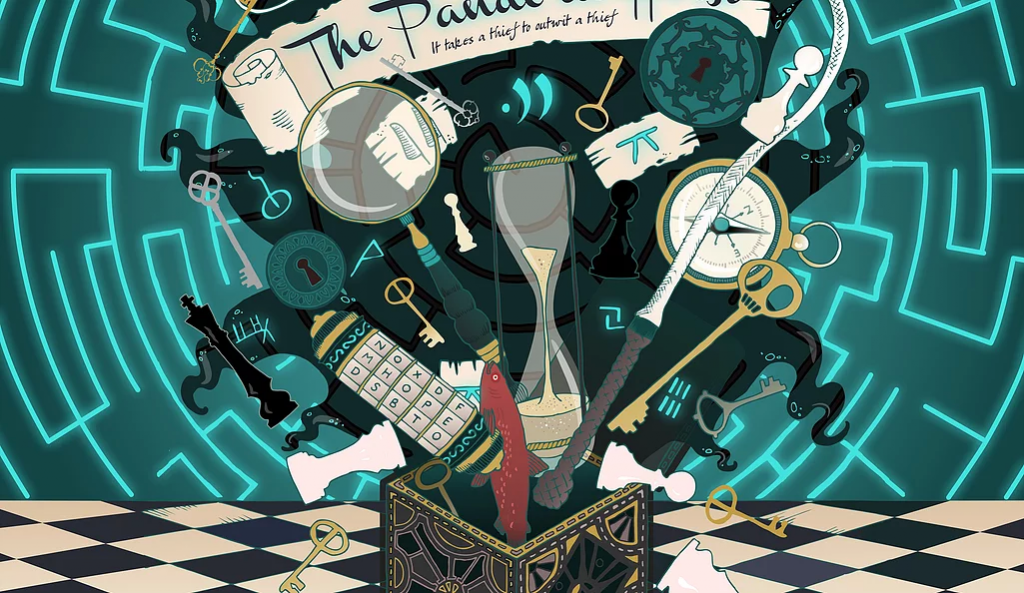Outside the room
It’s pretty rare that a company opens up in the UK without me having some idea of their background, but Elusion Rooms had come in under my radar and popped up with The Pandora Heist before I knew it. As luck would have it, we were passing through Southampton just three weeks after their opening, which was perfect from my point of view – early enough that I didn’t have any preconceptions from other enthusiasts’ visits but long enough for them to get to know the room.
As soon as you walk through their front door, you realise that they’re taking this seriously. They’ve gone to a lot of trouble to kit out the waiting area and show off their talents. My first reaction was that it was wasted effort but, as they pointed out when I complimented them on the design, it gave people assurance that they could deliver a great experience inside the room. For that matter, it also worked well in terms of starting the immersion before you even entered the game.
Background
A mysterious employer has hired your crack team of thieves to break into the home of another antiquities thief and steal a legendary artifact.
Break into the house, crack the vault and steal items in the house worth the most value
before the police arrive.
Inside the room
You won’t find a heist game with a better start than this one. I’m a firm believer that too many venues just throw you into the room and don’t consider how they could aid the experience by working on that initial transition. You need to leave the baggage of the outside world at the door, and the earlier you start breaking people into the story the better. Right from that moment, it was a gorgeous game. It really felt like I was breaking into a wealthy collector’s house, and that feeling was reinforced throughout the experience. The visually weakest parts of this game were stronger than any part of the vast majority of games I’ve played and, while at times it was “just” a study, it was still beautifully produced.
That initial break-in very much heralded the sense of exploration that I felt in this game. It wasn’t just a room or two tacked together but instead provided a real sense of trespassing in someone’s house. That, combined with the decoration, really made me feel immersed, to the point where at times I found myself speaking in a hushed tone for no real reason.
The puzzles weren’t quite as good as the decoration, but they were solid enough and felt a little bit trickier than the average game. That trickiness resulted in them not flowing quite as well as I’d have liked and us moving forward in jumps. They’d played off the collector/archaeologist theme to make puzzles that fitted the experience. At times that was little more than finding a particular prop to generate a number, but in other places it was far more involved and required some level of cross-referencing.
The whole story behind this room, which you’re told before you enter the space, is that you need to collect a specific artefact and can bring with you up to four others. The main artefact represents the win/loss condition of the game, while the remaining items have values that are effectively your score within the game. I’d suggest that, more or less, getting the main artefact felt very much like a traditional escape room. I was having a ball up to that point, but I felt that it rapidly unravelled thereafter.
For me, escape rooms are all about logic and certainty. Vague puzzles are bad: when you get the answer, you should be confident that it’s the right answer. The “bonus” parts of this game felt very much like a collection of increasingly vague puzzles instead of the increasingly challenging puzzles that I was looking for, which to my mind aren’t the same thing. It’s possible that I wasn’t even looking for proper puzzles but for some sort of task involving assimilating lots of information and coming up with our best options. When I left the room, I wanted them to tell me the things I had missed that would have convinced me to take a different set of items, but instead their reasons seemed vague.
We spent the last twenty minutes in the room, looking for extra information, discussing what we’d found and making a few good (but probably more bad) choices about what to take. I quite enjoyed the process, but at the end I couldn’t help but feel that we might have been better off just randomly choosing our artefacts…
Result
Our team of four escaped in 57 minutes but we chose… poorly, so we didn’t even make it on to the leaderboard, collecting a measly £1,034,200.
Verdict –
In my opinion, this game was close to greatness. It was a great concept, visually beautiful, with a fantastic start and solid central gameplay but, just as I was getting really excited, it let me down. It took what I hate about murder mysteries and transported it into an escape room setting. All the certainty that the early puzzles had provided was undone by a finish that felt more like a lottery than a puzzle challenge.
If murder mystery logic doesn’t frustrate you, then I think this is a great experience that I’d thoroughly recommend. But if, like me, you hate that kind of logic, then I’d still suggest playing but going in very much with your eyes open! Four players felt about right for this experience. You may be a little cosy early on, but that shouldn’t last too long.
Detailed Room Ratings
| Venue | |
| Host | |
| Wow! factor | |
| Immersiveness | |
| Difficulty |
